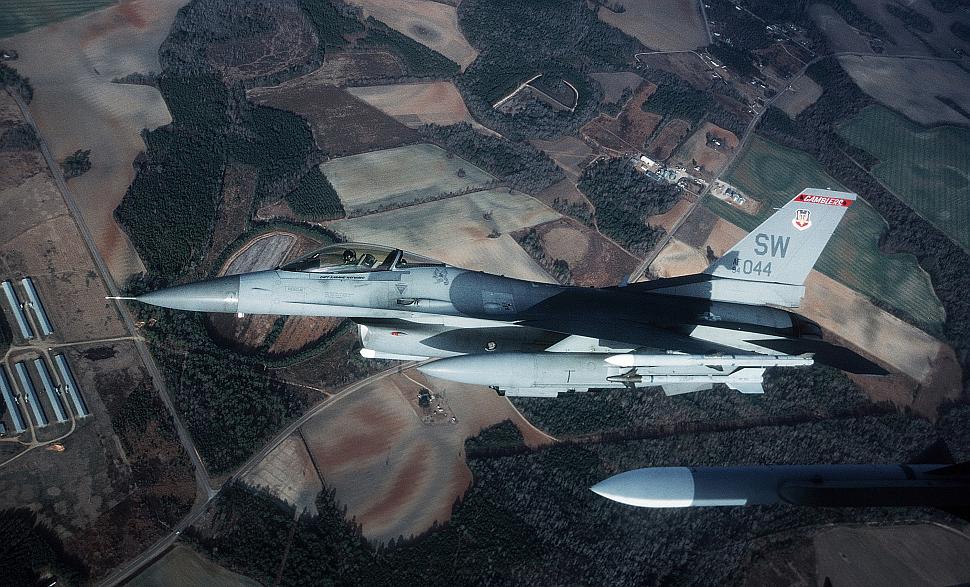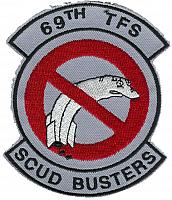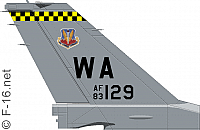 |
United States of America
Air Combat Command - ACC
|
Introduction
The United States Air Force is -not surprisingly- the single largest operator of F-16s, with well over 2,000 airframes being delivered. The USAF was the driving force behind the Light-weight fighter competition, and behind most of the modification and improvements of the F-16. The USAF also has (or has had) most versions and blocks in its inventory, from the YF-16 protoypes over the block 1 to the block 52, the notable exceptions being the recently developed Block 52+ and block 60 models and "upgrade" versions such as the MLU.
History
The USAF F-16 program can be traced back to the Advanced Day Fighter requirement. The Advanced Day Fighter requirement called for a simple design in the 25,000-pound class, and was to have a thrust-to-weight ratio and a wing loading intended to better the performance of the MiG-21 by at least 25 percent. The Advanced Day Fighter was to complement the heavier F-X fighter. The appearance of the Mach 2.8 MiG-25 Foxbat in 1967 frightened Defense Department analysts, and the high-performance F-X program became USAF's top priority (eventually resulting in the McDonnell Douglas F-15 Eagle). As a result, the Advanced Day Fighter was temporarily shelved.
In the late '60s, Maj. John Boyd picked up the Advanced Day Fighter and developed into a 25,000-pound design designated F-XX. The F-XX was a dedicated air superiority fighter with a high endurance, minimal electronics, and no long-range missiles. The USAF opposed the F-XX, since many high-ranking officials considered it a direct threat to the F-X program. However, the Pentagon decided to continue the project at a low level just in case the F-X (i.e. F-15) program got delayed or encountered serious developmental difficulties.
Inventory
Prototypes & Full Scale Development aircraft
The first USAF YF-16A prototype (#01567) in the standard prototype camouflage scheme. The YF-16 was designed to meet the ACF specification: a simple day fighter, without radar, and armed with only short-range missiles (USAF photo) In January 1971, Deputy Defense Secretary David A. Packard issued a Request for Proposal for the Light Weight Fighter (LWF) program. It called for a high thrust-to-weight ratio, a gross weight of less than 20,000 pounds, and high maneuverability. Five manufacturers submitted proposals in response to the RfP (Boeing, Northrop, General Dynamics, Ling-Temco-Vought, and Lockheed). The General Dynamics Model 401-16B and the Northrop P-600 were chosen for further development on April 13th, 1972, and contracts for two YF-16s (#72-1567 and #72-1568) and two YF-17s were awarded. Since the LWF was still seen as a threat to the F-15, the Defense Department renamed the program Air Combat Fighter (ACF).
The US Air Force's first F-16, a YF-16 prototype (#72-1567), was delivered to Edwards AFB on January 8th, 1974. In October of 1974, Defense Secretary James R. Schlesinger announced that the Pentagon was considering production of the winner of the ACF contest to satisfy USAF, Navy, and export requirements. The requirement explicitly called for a multirole fighter, so production ACF aircraft were to be fitted with a radar to give them a limited BVR capability. The multirole requirement also differentiated the ACF from the F-15 Eagle's pure air superiority role, easing Air Force fears that the ACF would sidetrack the F-15 program.
On January 13th, 1975, Air Force Secretary John McLucas announced that the YF-16 had been selected as the winner of the ACF contest. The Air Force placed a contract for fifteen FSD (Full-Scale Development) airframes, a number that was later reduced to 8 (6 F-16A/FSD's and 2 F-16B/FSD's). The first F-16A/FSD, #50745, was flown on December 8th, 1976.
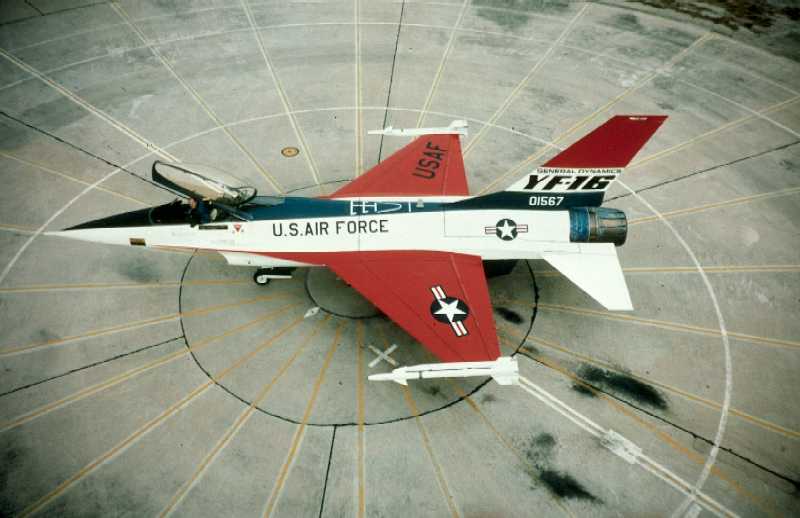
Production Aircraft
Early 1975, the USAF announced it would buy 650 F-16 multi-role fighters. The timing of this announcement was not coincidental, as the four European nations that were considering the F-16 as a replacement for their F-104 Starfighters wanted a firm commitment from the USAF before making their decision. At the same time, the USAF announced that the order could be extended to include as many as 1,400 F-16s.
In August 1975, General Dynamics' Fort Worth plant began producing the F-16, after a major overhaul of the plants production facilities. The production F-16A differed from the YF-16 in having a 13-inch fuselage extension to accommodate more fuel and the Westinghouse APG-66 radar. The wing area was increased by 20 square feet, and the horizontal stabilizer was also enlarged. An additional underwing hardpoint was fitted, bringing the total number of hardpoints to 9.
In 1977, the US Air Force announced it would buy an additional 783 F-16A/B's, which were going to enter service as fighter-bombers. The large orders (and subsequent orders) were spread over consecutive years, and F-16s have been ordered and delivered to the USAF in virtually every fiscal year. In total, 2,230 production F-16s have been ordered by the US Air Force. USAF orders (especially the early orders) were not for specific blocks of F-16s - when General Dynamics started producing a new block, they started delivering it to USAF. In the late 90s, the USAF placed a production extension order. The sole purpose of this order was to keep the Fort Worth production line open. At that time, the line was scheduled to close in 1999.
The first production F-16, F-16A Block 1 #78001, was accepted by the USAF on August 17th, 1978. F-16 airframes were delivered continuously during the following years. In total, 768 F-16A/Bs were delivered (43 Block 1, 73 block 5, 213 block 10 and 457 block 15). Two USAF F-16As were built by Fokker in the Netherlands, and three by SABCA in Belgium. Production of the F-16A/B for the USAF ended in the winter of 1984/85.
Production of the first block 25 F-16C/Ds began in 1984, with the first example being delivered to the USAF in July. By 1990, about 1,500 F-16s had been delivered, and production switched over to the Block 40/42 version. In 1992 production switched to Block 50/52. In total, 1,444 F-16C/Ds (244 Block 25, 407 block 30, 62 block 32, 266 block 40, 196 block 42, 216 Block 50 and 53 Block 52). Deliveries are scheduled to continue into 2004, with the last aircraft delivered being an F-16C Block 50.
USAF F-16s are opearated by most of the commands, including Air Combat Command (ACC, previously Tactical Air Command or TAC), Air National Guard (ANG), United States Air Forces Europe (USAFE), Pacific Air Forces (PACAF), Air Force Reserve Command (AFRC, previously AFRES), Air Education and Training Command (AETC), and Air Force Materiel Command (AFMC). The F-16 was one of the first aircraft types of which new models have been delivered directly to most commands (ACC, PACAF, USAFE, and even ANG). However, over the course of the years, available F-16s have been shifted around quite a bit between the different commands, with older models being passed on from active units to Guard and Reserve units.
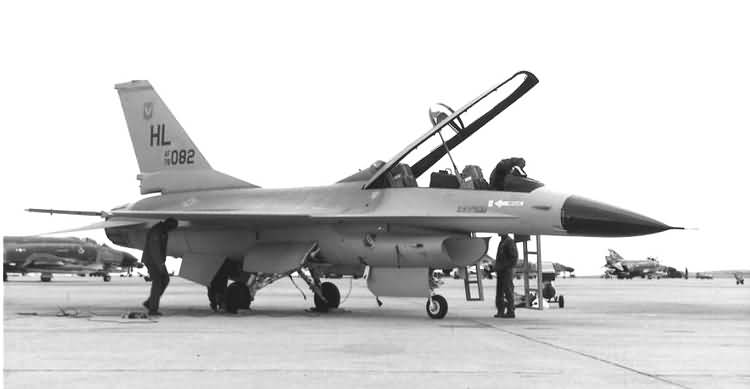
Air Combat Command/Tactical Air Command Inventory
Tactical Air Command was the first USAF command to receive the new F-16. On January 6th, 1979, the 388th Tactical Fighter Wing at Hill AFB received its first F-16A. One of the wings' squadrons, the 4th TFS 'Fightin' Fujins', was the first USAF squadron to achieve Initial Operational Capability (IOC) on November 12th, 1980. In March of 1981, the 4th TFS took twelve of its F-16s to Norway for a month-long deployment, marking the first deployment of the USAF F-16s overseas.
By the spring of 1982, 345 F-16s were in service with TAC units.
Most of the Block 25 and 30/32 have been transferred to AFRC and ANG units, and the ACC fleet now consists of Block 40/42 and 50/52 aircraft.
| Block | F-16A | F-16B | F-16C | F-16D | Total | Delivery |
|---|---|---|---|---|---|---|
| YF-16A | 2 | 2 | 1974 | |||
| FSD | 6 | 2 | 8 | 1976-1978 | ||
| Block 1 | 21 | 22 | 43 | 1978-198 | ||
| Block 5 | 46 | 27 | 73 | 1979-1980 | ||
| Block 10 | 188 | 25 | 213 | 1980-1981 | ||
| Block 15 | 409 | 48 | 457 | 1981-1985 | ||
| Block 25 | 209 | 35 | 244 | 1984-1986 | ||
| Block 30 | 359 | 48 | 407 | 1986-1989 | ||
| Block 32 | 57 | 5 | 62 | 1987-1989 | ||
| Block 40 | 232 | 34 | 266 | 1988-1993 | ||
| Block 42 | 152 | 44 | 196 | 1989-1992 | ||
| Block 50 | 188 | 28 | 216 | 1991-2004 | ||
| Block 52 | 41 | 12 | 53 | 1992-1996 | ||
| Totals | 664 | 122 | 1,238 | 206 | 2,230 |
| Program | Model | Block | Qty. | Serials | Delivered |
|---|---|---|---|---|---|
| FY 1972 | YF-16A | proto | 2 | 01567/01568 | 1974 |
| FY 1975 | F-16A | FSD | 6 | 50745/50750 | 1976-1978 |
| F-16B | FSD | 2 | 50751/50752 | 1977-1978 | |
| FY 1978 | F-16A | Block 1 | 21 | 78001/78021 | 1978-1979 |
| F-16B | Block 1 | 22 | 78077/78098 | 1978-1979 | |
| F-16A | Block 5 | 45 | 78022/78027, 78038/78076 | 1979-1980 | |
| F-16B | Block 5 | 17 | 78099/78115 | 1979-1980 | |
| FY 1979 | F-16A | Block 5 | 1 | 79288 | 1980 |
| F-16B | Block 5 | 10 | 79410/79419 | 1980 | |
| F-16A | Block 10 | 121 | 79289/79409 | 1980-1981 | |
| F-16B | Block 10 | 13 | 79420/79432 | 1980-1981 | |
| FY 1980 | F-16A | Block 10 | 67 | 80474/80540 | 1981 |
| F-16B | Block 10 | 12 | 80623/80634 | 1981 | |
| F-16A | Block 15 | 82 | 80541/80622 | 1981-1982 | |
| F-16B | Block 15 | 5 | 80635/80639 | 1981-1982 | |
| FY 1981 | F-16A | Block 15 | 149 | 81663/81811 | 1982-1983 |
| F-16B | Block 15 | 11 | 81812/81822 | 1982-1983 | |
| FY 1982 | F-16A | Block 15 | 126 | 82900/821025 | 1983-1984 |
| F-16B | Block 15 | 24 | 821026/821042, 821044/821049 | 1983-1984 | |
| FY 1983 | F-16A | Block 15 | 52 | 83066/83117 | 1984-1985 |
| F-16B | Block 15 | 8 | 83166/83173 | 1984-1985 | |
| F-16C | Block 25 | 48 | 83118/83165 | 1984-1985 | |
| F-16D | Block 25 | 12 | 83174/83185 | 1984-1985 | |
| FY 1984 | F-16C | Block 25 | 129 | 84212/84318, 84374/84395 | 1985-1986 |
| F-16D | Block 25 | 15 | 84319/84331, 84396/84397 | 1985-1986 | |
| FY 1985 | F-16C | Block 25 | 32 | Various in range 85399/85452 | 1986 |
| F-16D | Block 25 | 8 | 85506/85508, 85510, 85512, 85514/85516 | 1986 | |
| F-16C | Block 30 | 103 | Various in range 85398/85570 | 1986-1987 | |
| F-16D | Block 30 | 7 | 85509, 85511, 85513, 85517, 85571/85573 | 1986-1987 | |
| FY 1986 | F-16C | Block 30 | 131 | Various in range 86207/86371 | 1987-1988 |
| F-16D | Block 30 | 12 | 86042, 86053 | 1987-1988 | |
| F-16C | Block 32 | 34 | Various in range 86210/86299 | 1987 | |
| F-16D | Block 32 | 3 | 86039/86041 | 1987 | |
| FY 1987 | F-16C | Block 30 | 110 | Various in range 87217/87349 | 1988-1989 |
| F-16D | Block 30 | 26 | 87363/87368, 87370/87380, 87382/87390 | 1988-1989 | |
| F-16C | Block 32 | 23 | Various in range 87267/87333 | 1988-1989 | |
| F-16D | Block 32 | 2 | 87369, 87381 | 1988-1989 | |
| F-16C | Block 40 | 8 | 87350/87355, 87357, 87359 | 1988-1989 | |
| F-16D | Block 40 | 3 | 87391/87393 | 1989 | |
| F-16C | Block 42 | 5 | 87356, 87358, 87360/87362 | 1989 | |
| F-16D | Block 42 | 3 | 87394/87396 | 1989 | |
| FY 1988 | F-16C | Block 30 | 15 | 88397/88411 | 1989 |
| F-16D | Block 30 | 3 | 88150/88152 | 1989 | |
| F-16C | Block 40 | 95 | Various in range 88413/88550 | 1989-1990 | |
| F-16D | Block 40 | 7 | 88166, 88168, 88170/88174 | 1989-1990 | |
| F-16C | Block 42 | 44 | Various in range 88412/88548 | 1989-1990 | |
| F-16D | Block 42 | 16 | 88153/88165, 88167, 88169, 88175 | 1989-1990 | |
| FY 1989 | F-16C | Block 40 | 102 | various in range 89000/89153 | 1990-1991 |
| F-16D | Block 40 | 10 | 89166/89169, 89171/89174, 89176, 89178 | 1990-1991 | |
| F-16C | Block 42 | 53 | Various in range 89002/89154 | 1990-1991 | |
| F-16D | Block 42 | 15 | 89155/89165, 89170, 89175, 89177, 89179 | 1990-1991 | |
| FY 1990 | F-16C | Block 40 | 27 | Various in range 90703/90776 | 1991-1993 |
| F-16D | Block 40 | 14 | Various in range 90777/90800 | 1991-1992 | |
| F-16C | Block 42 | 50 | Various in range 90700/90770 | 1991-1992 | |
| F-16D | Block 42 | 10 | 90778, 90781, 90783, 90785/90790, 90793 | 1991-1992 | |
| F-16C | Block 50 | 32 | 90801/90808, 90810/90833 | 1991-1993 | |
| F-16D | Block 50 | 15 | 90834, 90838, 90840, 90849 | 1992-1993 | |
| F-16C | Block 52 | 1 | 90809 | 1992 | |
| F-16D | Block 52 | 1 | 90839 | 1992 | |
| FY 1991 | F-16C | Block 50 | 79 | Various in range 91336/91423 | 1993-1994 |
| F-16D | Block 50 | 13 | Various in range 91462/91481 | 1993-1994 | |
| F-16C | Block 52 | 9 | Various in range 91362/91413 | 1993-1994 | |
| F-16D | Block 52 | 7 | 91466/91467, 91470, 91473, 91475, 91478/91479 | 1993-1994 | |
| FY 1992 | F-16C | Block 50 | 24 | Various in range 92883/92923 | 1994-1995 |
| F-16C | Block 52 | 19 | Various in range 92880/92917 | 1994-1995 | |
| F-16D | Block 52 | 4 | 92924/92927 | 1994 | |
| FY 1993 | F-16C | Block 50 | 12 | Various in range 93532/93554 | 1995-1996 |
| F-16C | Block 52 | 12 | Various in range 93531/93553 | 1994-1996 | |
| FY 1994 | F-16C | Block 50 | 12 | 94038/94049 | 1996-1997 |
| FY 1996 | F-16C | Block 50 | 6 | 96080/96085 | 1999 |
| FY 1997 | F-16C | Block 50 | 6 | 97106/97111 | 2000 |
| FY 1998 | F-16C | Block 50 | 3 | 98003/98005 | 2001 |
| FY 1999 | F-16C | Block 50 | 1 | 99082 | 2001 |
| FY 2000 | F-16C | Block 50 | 10 | 00218/00227 | 2002-2003 |
| FY 2001 | F-16C | Block 50 | 4 | 01050/01053 | 2004 |
| Ex-Pak. | F-16A | block 15OCU | 5 | (random nrs) | 2003 |
| F-16B | Block 15OCU | 9 | (random nrs) | 2003 |
Modifications & Armament
Armament
The United States Air Force assignes the different blocks to specific missions. In general, block 25 and 30/32 F-16s are used in the Air Defense role, block 40/42 aircraft in the Close Air Support/Ground Attack role with LANTIRN, and block 50/52 aircraft in the SEAD role with the HTS. However, this does not imply that block 50 aircraft are not suited for air defense, or that block 30 aircraft cannot fire the HARM. Most F-16C/D aircraft have received the same software upgrades and can use the same weapon systems. For example, block 30 aircraft have been sighted carrying the HARM missile.
F-16CJ Block 52D from Shaw AFB, configured for the SEAD mission: wingtip AIM-120 AMRAAMs, AIM-9M Sidewinders on stations 2 and 8, and AGM-88 HARM anti-radiation missile on 3 and 7. Note the AN/ASQ-213 Harm Targetting System pod on the starboard intake station. (USAF photo by Greg L. Davis) USAF Air Combat Command F-16s are used in a variety of roles, from air superiority to SEAD. As a result, USAF F-16s can be equipped with a variety of weapons and stores. Operational ACC F-16 units use amongst others the following types of armament:
Standard air-to-air armament for USAF F-16s is the AIM-9L/M Sidewinder and AIM-120 AMRAAM. In 1996, the improved AIM-120C was added to the inventory. The AIM-120C has an improved guidance section, warhead, and propulsion, and can be easily identified by its clipped wings. The CCIP modification of block 40/42/50/52 aircraft will also see the introduction of the AIM-9X off-boresight missile, which is used in combination with the Joint Helmet-Mounted Cueing System (JHMCS).
Air Combat Command F-16s use the AGM-88 HARM missile for the SEAD or 'Wild Weasel' role. This mission is performed by block 50/52 aircraft equipped with the chin-mounted AN/ASQ-213 HARM Targeting System (HTS). The AGM-45 Shrike missile is no longer used by the USAF, although 'Wild Weasel' F-16s are capable of using it.
In the air-to-ground mission, USAF F-16s uses a variety of free-fall bombs. These include the Mk.80 series of unguided free-fall bombs and cluster bombs. In the category guided weapons, USAF F-16s use Laser Guided Bombs in combination with the LANTIRN pods and the AGM-65 Maverick missiles. F-16s have also used the GBU-15 electro-optic guided bombs (EOGB). Recently, the GBU-31 JDAM GPS-guided bomb was added to the inventory. F-16s are currently being certified for advanced weapons such as the Joint Stand-Off Weapon (JSOW) glide bomb, Wind Corrected Munitions Dispenser (WCMD) inertially-guided cluster bomb, and the Joint Air To Surface Standoff Missile (JASSM) cruise missile.
In the anti-ship role, USAF F-16s have used the AGM-84 Harpoon. The Harpoon is no longer used by USAF F-16s, with the AGM-64 Maverick being used agains small surface vessels.
USAF F-16s can also carry the Durandal anti-runway munition, although it does not seem to be a widepspread practice. Of course, USAF F-16s can also carry a variety of unguided munitions such as practice bombs, rocket pods, napalm canisters, etc.
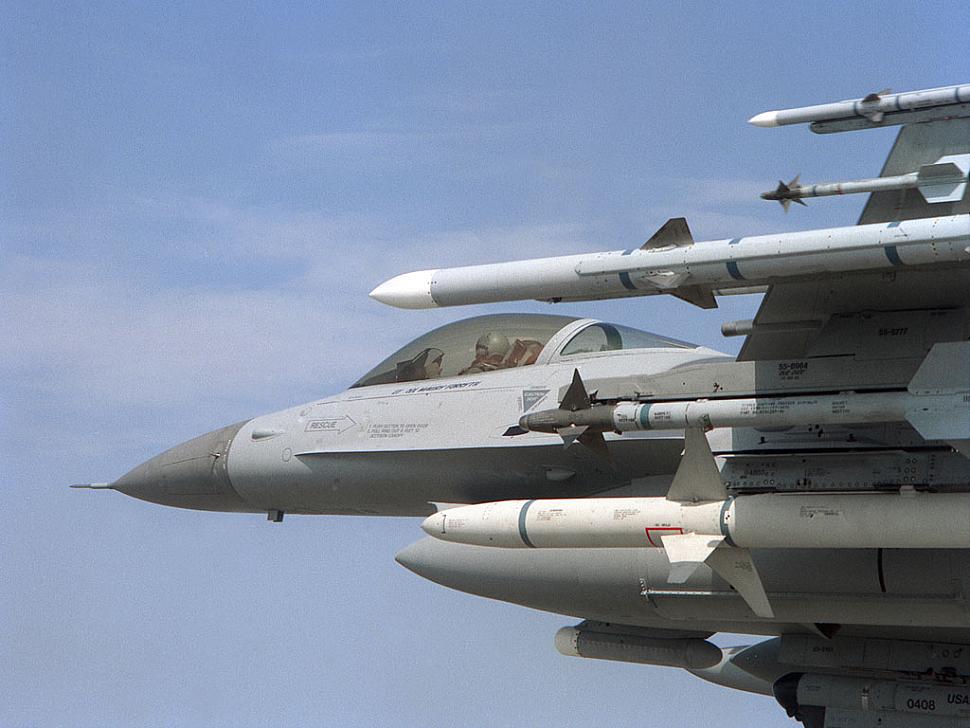
Electronic Counter Measures
USAF Air Combat Command F-16s carry the AN/ALQ-131 and AN/ALQ-184 ECM pods. Block 30/32/40/42 models are fitted with the AN/ALR-74 internal radar warning receiver (RWR), which replaces the AN/ALR-69. Block 50/52 models are equipped with the more advanced AN/ALR-56M threat warning receiver, since they can be used in the SEAD role. Block 40 models are equipped with the AN/AAR-57 Common Missile Warning System (CMWS) for the CAS role. USAF F-16s are equipped with the AN/ALE-40 chaff/flare dispenser, which has been replaced with the AN/ALE-47 in the most recent models.
Navigation and Targeting pods
USAF Air Combat Command uses the LANTIRN navigation and targeting pods on its F-16s. Block 50/52 aircraft that fly SEAD missions are fitted with the AN/ASQ-213 HARM Targeting System (HTS).
Common Configuration Implementation Program
Starting in 1998, Block 40/42/50/52 aircraft are being upgraded under the Common Configuration Implementation Program (CCIP). This modification incorporates a number of systems originally designed for the European MLU program into the existing fleet of USAF Block 40/42/50/52 aircraft. The CCIP configuration includes the following systems: Modular Mission Computer, Color Multifunction Display Set, Common Data Entry Electronics Unit, Electronic Horizontal Situation Indicator, Joint Helmet Mounted Cueing System (JHMCS), Link 16 Multifunction Information Distribution System (MIDS) and Low Volume Terminal with TACAN. This modification will be cost-efficient due to a common type certification and stock savings. The modifications will also greatly enhance the fleet's flexibility.
Operational Service
Units
Please refer to the F-16 Units section for an overview of units.Deployments
The USAF has been active all over the world since WWII. In general, as soon as a new fighter type reached IOC in a unit, it has been deployed overseas. This is also the case with the F-16. From the early eighties on F-16s have been deployed overseas, both to permanent Forward Operating Bases in Europe and Asia, and on exercises. In the past 15 years, F-16s have participated in three major campaigns. The first time was in 1990-1991 in operation 'Desert Storm', the second time in 1999 in operation 'Allied Force' and the last time in 2003 during operation 'Iraqi Freedom'. In between these major campaigns, F-16s have participated constantly in minor campaigns and peacekeeping operations. They will continue to do so in the next decade, simply because the F-16 will remain USAF's workhorse in the foreseeable future. The burden of these deployments has been shared by all USAF commands that operate the F-16. ACC and ANG units provide the majority of aircraft and personnel, with AFRC, USAFE and PACAF contributing as well.
|
Desert Storm Iraq The F-16 was used in the Persian Gulf war of 1991 in larger numbers than any other fighter, with 249 F-16A's and C's seeing action. The US ANG had two units flying the F-16A, while all the regular USAF were flying the C models. Many of the F-16s sent to the Gulf were Block 40 models. However, since LANTIRN targeting pods were still in short supply, and since the F-15E force had higher priority, only 72 of the F-16s used during Desert Storm were fitted with LANTIRN pods (most of them carrying only the navigation pod). With out the targeting pod, the three squadrons of block-40's were unable to drop laser guided bombs. The majority of the F-16 force was forced to fly during daylight hours. Operation Desert Storm began on January 17th, 1991, with coordinated air attacks against Iraq. The F-16 played a major role in the air campaign, performing 25 percent of all sorties and attacking a wide range of targets including fixed sites, radar systems, and vehicles. Typical weapons used by F-16s during Desert Storm were Mk.84 bombs and Mk.82 bombs, CBU-52 and CBU-58 cluster munitions, the CBU-87 Combined Effects Munitions, and the AIM-65 Maverick air-to-ground missile. Most of the Mavericks used in the Gulf War were the AGM-65D infrared version, which proved ideal in dry desert conditions. A few of the older AGM-65A/B television-guided Mavericks were also used. The kill rate for the Maverick was claimed to be about 80 percent, but its high cost limited its use to high-value targets such as tanks. Early in Desert Storm, it was thought that the F-16s might encounter significant air-to-air opposition, so they carried four AIM-9 Sidewinder missiles, one on each wing tip and one on each of the outboard under wing stations. As the Iraqi air-to-air threat diminished, the Sidewinder load was reduced to only two, carried on the wingtips. With the Iraqi air force having been knocked out during the first few days of the war or forced to flee to Iran, F-16s never got the chance to tangle with Iraqi fighters, and no air-to-air kills were scored by F-16s during Desert Storm. All of the Iraqi fixed-wing aircraft downed in air-to-air combat by USAF fighters were shot down by F-15C Eagles. |
|
|
Operation Northern Watch & Operation Southern Watch Following Desert Storm, a no-fly zone was established over Iraq in April 1991 and designated Operation Southern Watch. The no-fly zone was the airspace below the 32nd parallel. At the same time Operation Southern Watch was initiated Operation Provide Comfort started in the North. This was an effort to protect the Kurds which were being slaughtered by Saddam's forces and not allowed into Turkey. When Provide Comfort ended it was renamed Operation Northern Watch which began on January 1st, 1997. It was the 36th parallel that was the line of division for Northern Watch, all Iraqi airspace north of this parallel. The no-fly zones were regularly patrolled by the USAF and eventually air forces of various nations. Operations Northern and Southern Watch were extremely demanding on the Air Force in the 1990's. Many regular units found themselves deployed for extended times of the year away from friends and family. Not only because of the no-fly zones over Iraq, but also events in Bosnia were requiring much of the USAF resources. |
|
|
Operation Allied Force Balkan Even more than in operation Desert Storm, operation Allied Force was dominated by the F-16. This time not only USAF F-16s participated, but also F-16s from European air forces. A wide variety of missions were flown with the F-16 including CAP, strike, reconnaissance, SEAD, etc. The operation started at 19:00 hr on March 24th, 1999 and lasted until June 10th. This was the first operation which saw a large deployment of SEAD F-16s. In operation Desert Storm they were not ready to perform this mission and it was done by F-4G Phantoms. During this campaign, new technologies were also tested in a real-time operation. This included the first test with the JDAM bomb. After the war this bomb was adjusted with the results of the usage in Allied Force. |
|
|
Operation Enduring Freedom/Noble Eagle USA Operation Noble Eagle was a direct result of the attacks on America on September 11th, 2001. Fear of more attacks, especially from hijacked airliners, caused fighter bases around North America to scramble their aircraft. American fighter pilots were faced with the possibility that they could have to shoot down civilian airliners. Particular attention was paid to the skies over New York City and Washington DC where 2 fighters were kept in flight 24 hours a day. At various bases all over North America, units kept aircraft on alert to launch on 10 minutes notice. Operation Noble Eagle was a defensive role against attacks on the United States. The offensive against whom was behind the attacks was called Operation Enduring Freedom. War in Afghanistan was not something to take lightly and the controlling Taliban was known as potent fighters. In fact the Taliban had been trained by the United States to fight against the Soviet Union. A very poor country and a low technology guerilla style warfare gave the Russians loss in the 80's. American forces found themselves facing another possible Vietnam. A different approach was needed, so special forces recruited forces in Afghanistan to help their fight against the Taliban. The war was mostly to be a ground war, so F-16s mostly found themselves in a role of close-air-support. Early on, some F-16 units were tasked with the role of aerial cover, but this changed when it became obvious there was no threat from Afghan aircraft and their role was changed to bombing. Operation Enduring Freedom was a success and the Taliban was either eliminated or on the run. |
|
|
Operation Iraqi Freedom As in 1991, the F-16 played a major part in this conflict. Many lessons were learned for the F-16 from the USAF's many recent operations. The F-16 was a much more formidable weapon then the last war in Iraq. The operation began with an air campaign, targeted at destroying the Iraqi defense capabilities, or what was left of them. Tactics were quite similar to the ones used during operation Desert Storm in 1991. New weapons were tested, one of them being the AGM-154 JSOW. Before releasing it into production, it will be altered with the data gathered from operation Iraqi Freedom. Units of all commands stay in the Arab peninsula to provide air cover for the ongoing military operations there. This time even stationed in Iraq. |
Please use this form to add any list any error or omissions you find in the above text.
Note: your comments will be displayed immediately on this page. If you wish to send a private comment to the webmasters, please use the Contact Us link.

